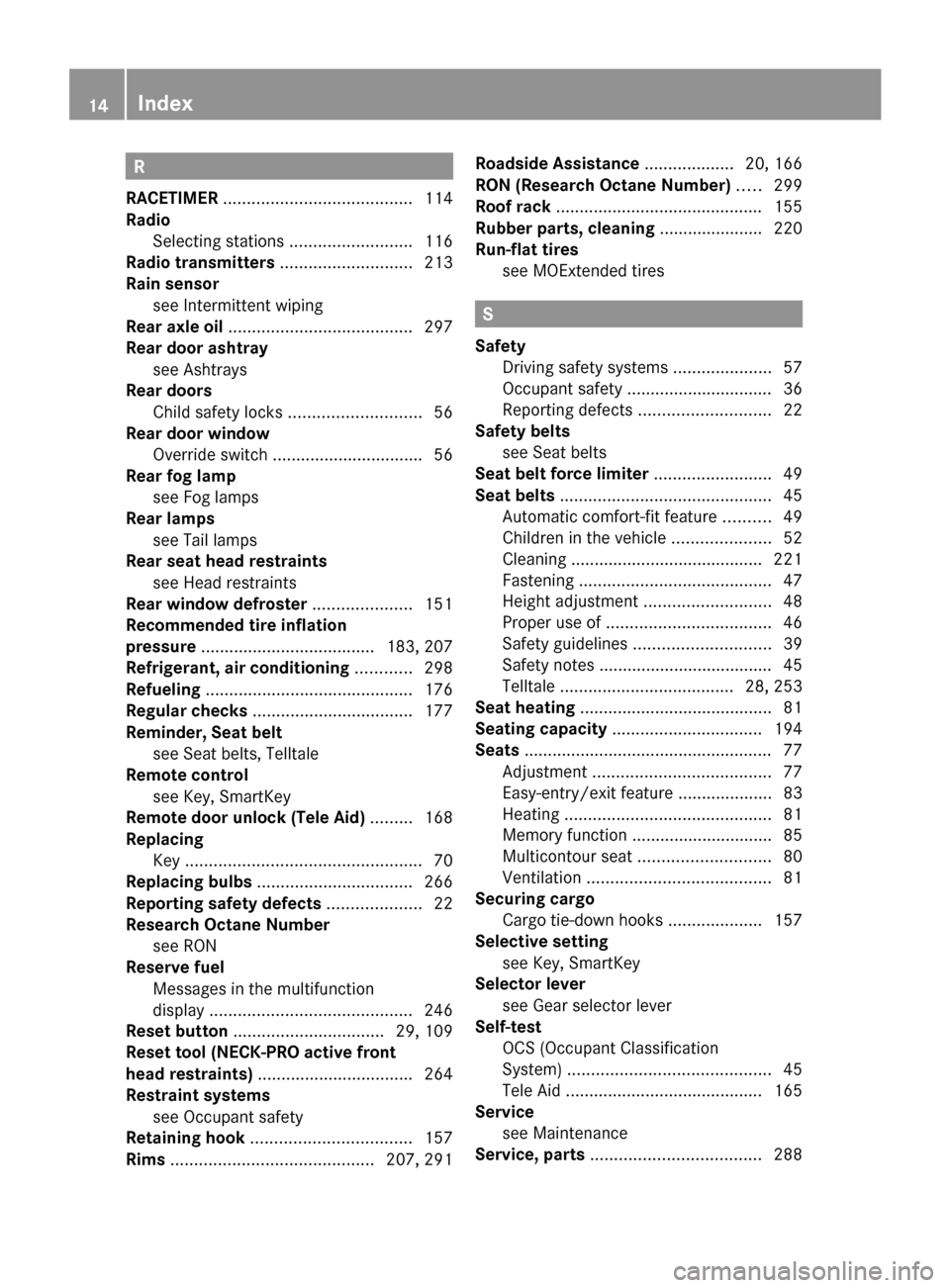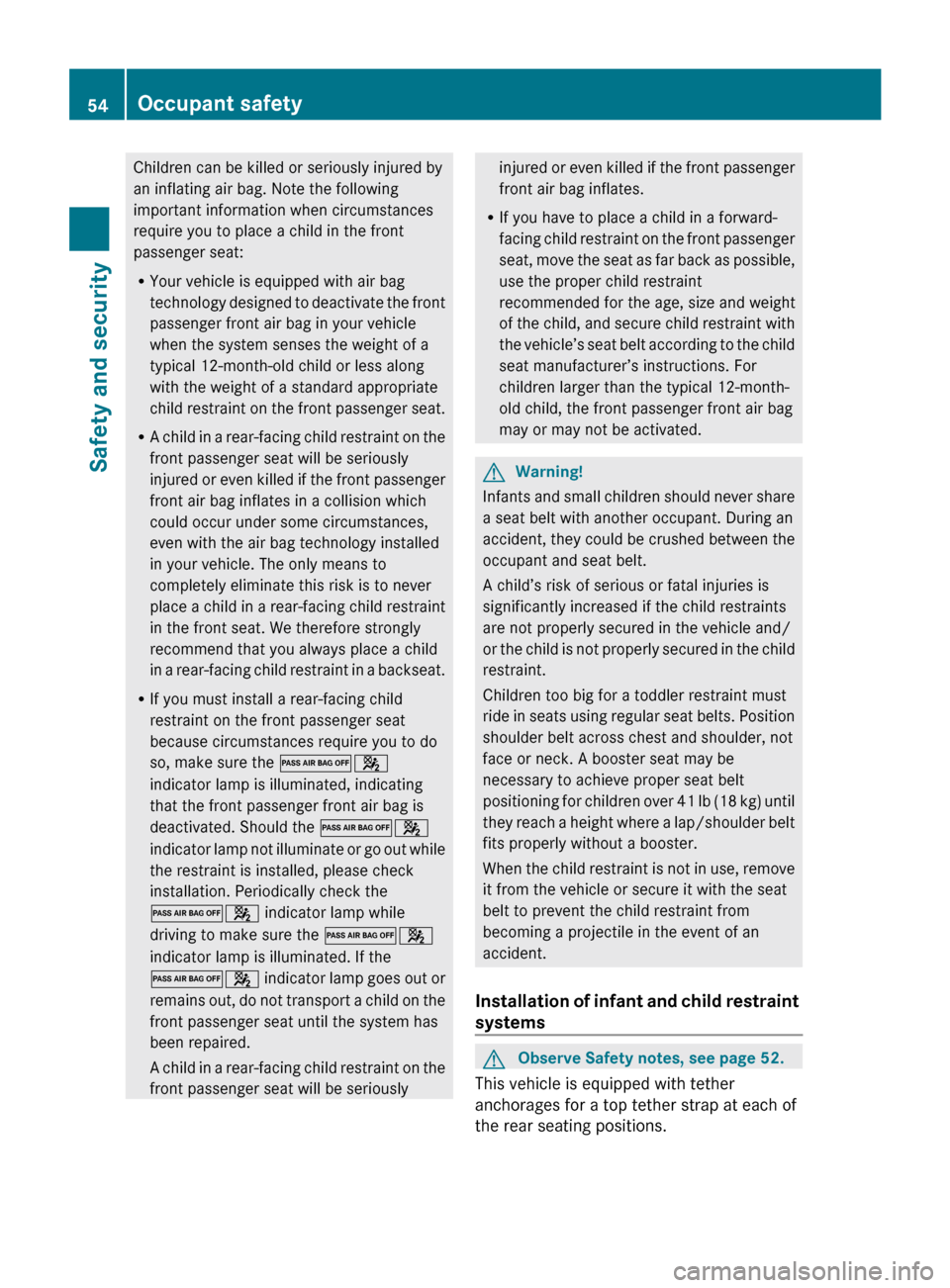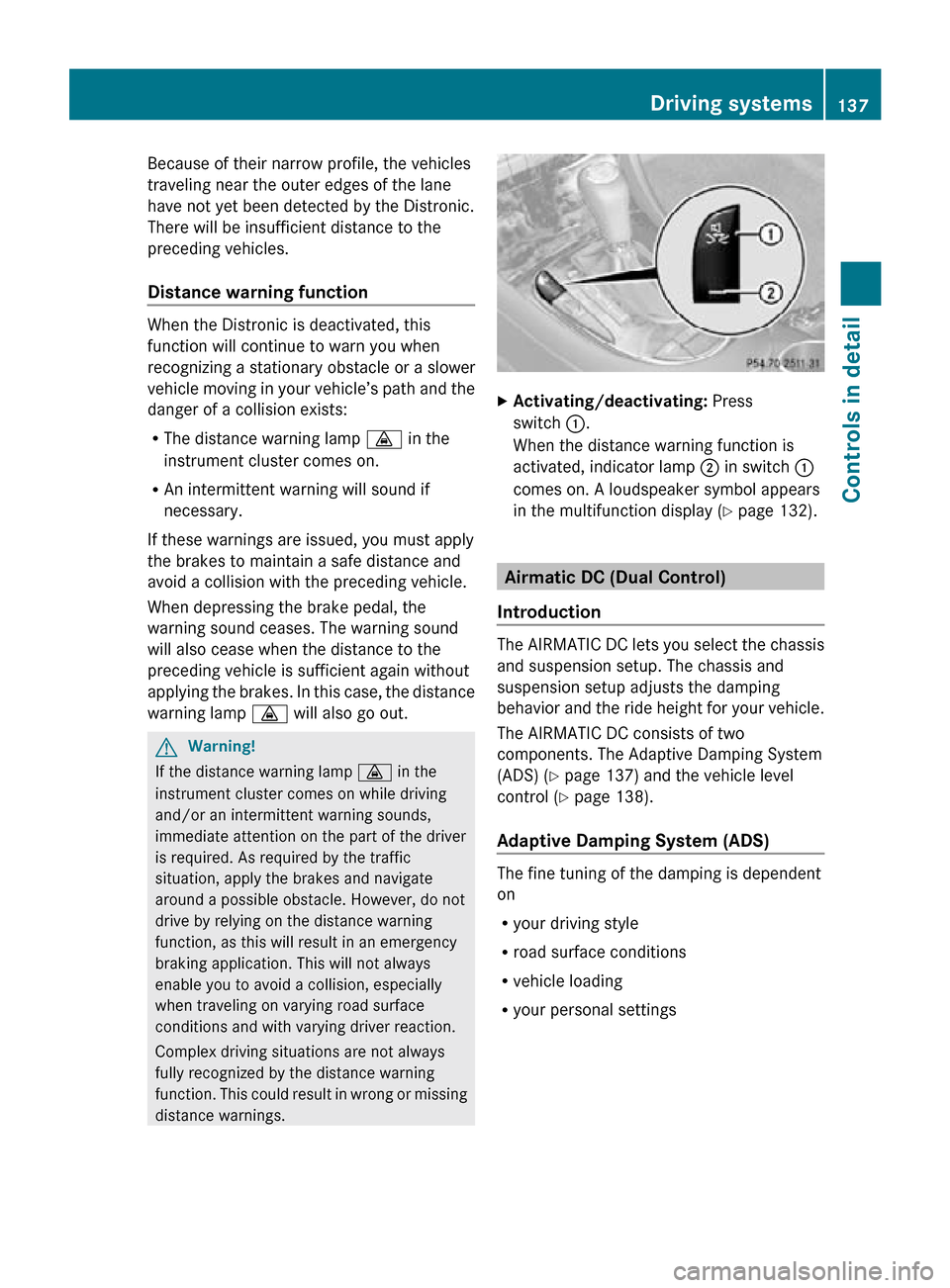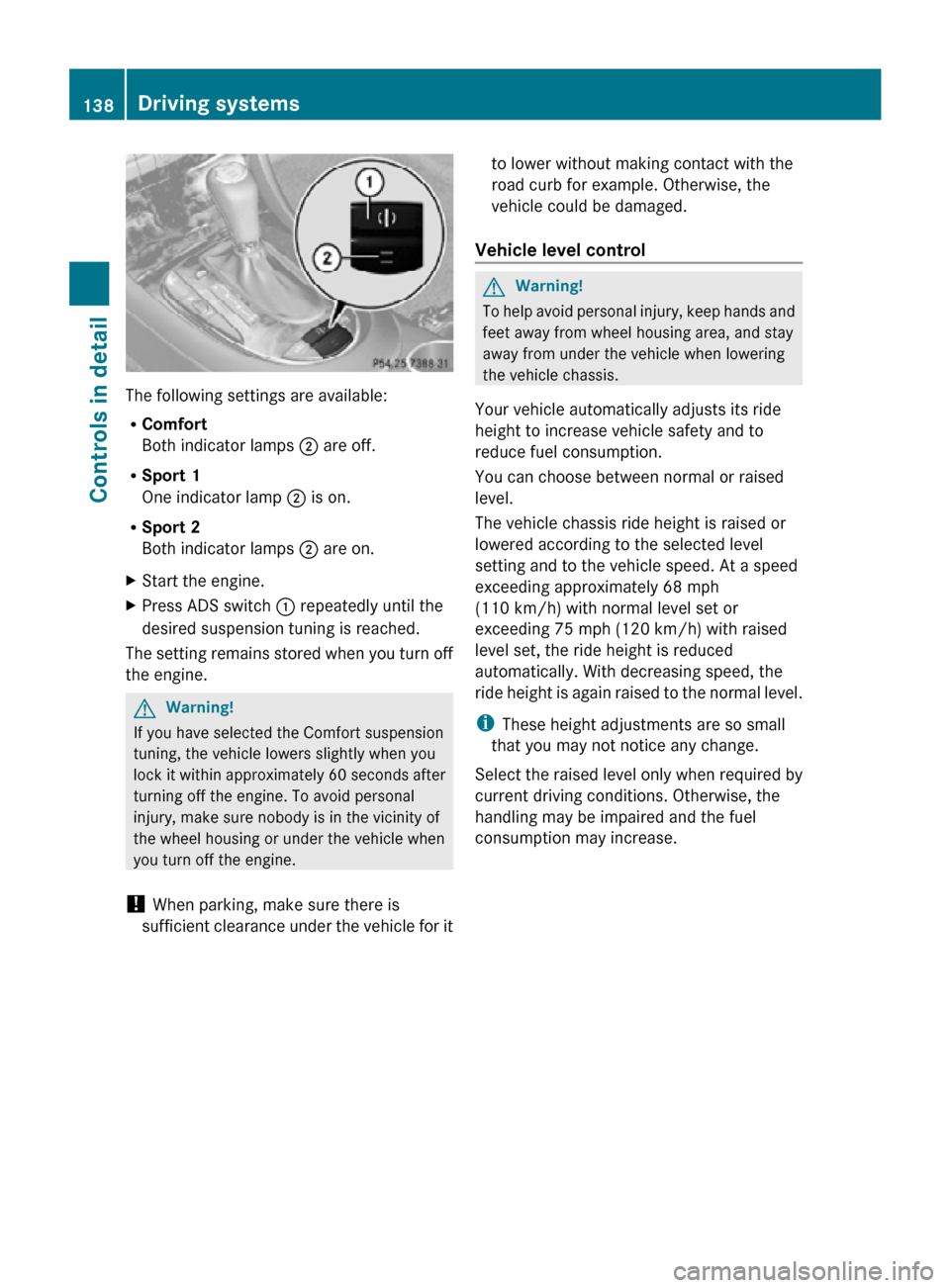2010 MERCEDES-BENZ CLS550 Air ride
[x] Cancel search: Air ridePage 7 of 308

Gear selector lever
........................102
Kickdown ....................................... 104
Kickdown (manual shift program)
..108
Manual shift program ..................... 107
One-touch gearshifting ..................105
Program mode indicator ................105
Program mode selector switch
(automatic shift program) ..............105
Program mode selector switch
(manual shift program) ..................107
Shifting procedure ......................... 102
Steering wheel gearshift control .... 106
Transmission position indicator ..... 103
Transmission positions .................. 103
AUX socket ........................................ 158
Axle oils .............................................. 297B
Backrest see Seats
Backup lamps
Messages in the multifunction
display ........................................... 247
Bar (air pressure unit) ....................... 206
BAS (Brake Assist System) ................. 59
Batteries, SmartKey
Checking condition ..........................69
Replacing ....................................... 264
Battery, Vehicle ................................. 278
Charging ........................................ 279
Jump starting ................................. 280
Messages in the multifunction
display ........................................... 245
Bead (tire) .......................................... 206
Beverage holders see Cup holders
Brake Assist System
see BAS
Brake fluid
Checking level ............................... 182
Messages in the multifunction
display ........................................... 239
Brake lamps
Cleaning lenses ............................. 219
Brake pads
Messages in the multifunction
display ........................................... 238Brakes
................................................ 210
High-performance brake system .... 212
Parking brake ................................ 100
Warning lamp .................................
252
Break-in period .................................. 176
Bulbs see Replacing bulbs C
CAC (Customer Assistance Center) ...22
California retail buyers and
lessees, important notice for .............20
Calls (phone) ...................................... 125
Can holders see Cup holders
Capacities and recommended
fuel/lubricants .................................. 296
Carpets, cleaning .............................. 221
Center console ..................................... 31
Central locking
Automatic ................................ 71, 123
KEYLESS-GO .................................... 67
Locking/unlocking from inside ........ 71
SmartKey ......................................... 66
Central locking/unlocking switch .....71
Certification label .............................. 288
Children in the vehicle
Air bags ........................................... 37
Child safety locks (rear doors) ......... 56
Child seat anchors – LATCH-type
(ISOFIX) ........................................... 55
Indicator lamp, front passenger
front air bag off ................................ 41
Infant and child restraint systems .... 53
ISOFIX (Child seat anchors –
LATCH-type) ..................................... 55
OCS (Occupant Classification
System) ........................................... 41
Override switch ................................ 56
Safety notes ..................................... 52
Tether anchorage points .................. 54
Top tether ........................................ 54
Child safety
see Children in the vehicle
Child seat anchors – LATCH-type
(ISOFIX)
see Children in the vehicle Index
5 219_AKB; 4; 54, en-US
d2ureepe,
Version: 2.11.8.1 2009-05-11T16:21:02+02:00 - Seite 5
Page 15 of 308

Children in the vehicle
.....................52
Child seat anchors – LATCH-type
(ISOFIX) ........................................... 55
Fastening the seat belts ...................
47
Front passenger front air bag off
indicator lamp .......................... 41, 260
Infant and child restraint systems .... 53
Introduction ..................................... 36
ISOFIX (Child seat anchors –
LATCH-type) ..................................... 55
OCS (Occupant Classification
System) ........................................... 41
PRE-SAFE ®
....................................... 49
Seat belts .................................. 39, 45
OCS (Occupant Classification
System) ................................................ 41
Self-test ........................................... 45
Odometer ........................................... 111
Oil, oil level see Engine oil
On-board computer
see Control system
One-touch gearshifting .....................105
Operating safety .................................. 21
Ornamental moldings, cleaning .......218
Outside temperature see Displays
Overhead control panel ......................33 P
Paintwork, cleaning ..........................217
Paintwork code ................................. 289
Panic alarm .......................................... 57
Parcel net ........................................... 157
Parking ............................................... 100
Parktronic system ..........................139
Parking and standing lamp
Replacing bulbs
............................. 267
Parking brake .................................... 100
Messages in the multifunction
display ........................................... 239
Parking position
Exterior rear view mirrors ................ 85
Transmission position .................... 103
Parktronic system
Cleaning system sensors ...............219
Malfunction .................................... 142 Minimum distance .........................
141
Sensor range ................................. 140
Switching on/off
........................... 141
System sensors ............................. 140
Warning indicators ................... 27, 141
Parts service ...................................... 288
PASS AIR BAG OFF indicator lamp see Front passenger front air bag
off indicator lamp
Passenger safety
see Occupant safety
Pedals ................................................. 210
Phone see Telephone
Plastic parts, cleaning ...................... 220
Power assistance .............................. 210
Power outlets .................................... 163
Power seats see Seats
Power tilt/sliding sunroof
Operation ....................................... 152
Synchronizing ................................ 154
Power washer .................................... 217
Power windows ................................... 94
Cleaning ......................................... 219
Operation ......................................... 94
Rear door window, override
switch .............................................. 56
Synchronizing .................................. 95
Practical hints ................................... 224
PRE-SAFE ®
............................................ 49
Messages in the multifunction
display ........................................... 229
Problems
While driving .................................... 99
With vehicle ..................................... 22
With wipers ...................................... 94
Product information ............................19
Production options weight ...............207
Program mode selector switch
Automatic shift program ................105
Manual shift program ..................... 107
Proximity key
see Key, SmartKey
PSI (air pressure unit) ....................... 207 Index
13 219_AKB; 4; 54, en-US
d2ureepe,
Version: 2.11.8.1 2009-05-11T16:21:02+02:00 - Seite 13
Page 16 of 308

R
RACETIMER ........................................ 114
Radio Selecting stations
..........................116
Radio transmitters ............................213
Rain sensor see Intermittent wiping
Rear axle oil ....................................... 297
Rear door ashtray see Ashtrays
Rear doors
Child safety locks ............................ 56
Rear door window
Override switch ................................ 56
Rear fog lamp
see Fog lamps
Rear lamps
see Tail lamps
Rear seat head restraints
see Head restraints
Rear window defroster ..................... 151
Recommended tire inflation
pressure ..................................... 183, 207
Refrigerant, air conditioning ............ 298
Refueling ............................................ 176
Regular checks .................................. 177
Reminder, Seat belt see Seat belts, Telltale
Remote control
see Key, SmartKey
Remote door unlock (Tele Aid) .........168
Replacing
Key .................................................. 70
Replacing bulbs ................................. 266
Reporting safety defects .................... 22
Research Octane Number see RON
Reserve fuel
Messages in the multifunction
display ........................................... 246
Reset button ................................ 29, 109
Reset tool (NECK-PRO active front
head restraints) ................................. 264
Restraint systems see Occupant safety
Retaining hook .................................. 157
Rims ........................................... 207, 291Roadside Assistance
...................20, 166
RON (Research Octane Number) ..... 299
Roof rack ............................................ 155
Rubber parts, cleaning ......................
220
Run-flat tires see MOExtended tires S
Safety Driving safety systems ..................... 57
Occupant safety ...............................
36
Reporting defects ............................ 22
Safety belts
see Seat belts
Seat belt force limiter ......................... 49
Seat belts ............................................. 45
Automatic comfort-fit feature .......... 49
Children in the vehicle .....................52
Cleaning ......................................... 221
Fastening ......................................... 47
Height adjustment ...........................48
Proper use of ................................... 46
Safety guidelines ............................. 39
Safety notes ..................................... 45
Telltale ..................................... 28, 253
Seat heating ......................................... 81
Seating capacity ................................ 194
Seats ..................................................... 77 Adjustment ...................................... 77
Easy-entry/exit feature ....................83
Heating ............................................ 81
Memory function .............................. 85
Multicontour seat ............................ 80
Ventilation ....................................... 81
Securing cargo
Cargo tie-down hooks .................... 157
Selective setting
see Key, SmartKey
Selector lever
see Gear selector lever
Self-test
OCS (Occupant Classification
System) ........................................... 45
Tele Aid .......................................... 165
Service
see Maintenance
Service, parts .................................... 28814
Index 219_AKB; 4; 54, en-US
d2ureepe,
Version: 2.11.8.1 2009-05-11T16:21:02+02:00 - Seite 14
Page 23 of 308

contacting you in a timely manner should the
need arise.
If you sell your Mercedes, please leave all
literature
with the vehicle to make it available
to the next operator.
If you bought this vehicle used, be sure to
send in the “Notice of Purchase of Used Car”
found in the Service and Warranty
Information Booklet, or call the Mercedes-
Benz Customer Assistance Center (in the
USA) at 1-800-FOR-MERCedes, or Customer
Service (in Canada) at 1-800-387-0100. Operating your vehicle outside the
USA or Canada
If you plan to operate your vehicle in foreign
countries, please be aware that:
R Service
facilities or replacement parts may
not be readily available.
R Unleaded gasoline for vehicles with
catalytic converters may not be available;
the use of leaded fuels will damage the
catalysts.
R Gasoline may have a considerably lower
octane rating, and improper fuel can cause
engine damage.
Certain Mercedes-Benz models are available
for delivery in Europe under our European
Delivery Program. For details, consult an
authorized Mercedes-Benz Center or write to:
In the USA:
Mercedes-Benz USA, LLC
European Delivery Department
One Mercedes Drive
Montvale, NJ 07645-0350
In Canada:
Mercedes-Benz Canada, Inc.
European Delivery Department
98 Vanderhoof Avenue
Toronto, Ontario M4G 4C9 Operating safety
G
Warning!
Work improperly carried out on electronic
components and associated software could
cause
them to cease functioning. Because the
vehicle’s electronic components are
interconnected, any modifications made may
produce an undesired effect on other
systems. Electronic malfunctions could
seriously impair the operating safety of your
vehicle.
Contact an authorized Mercedes-Benz Center
for repairs or modifications to electronic
components.
Other improper work or modifications on the
vehicle could also have a negative impact on
the operating safety of the vehicle.
Some safety systems only function while the
engine is running. You should therefore never
turn off the engine while driving. G
Warning!
Heavy blows against the vehicle underbody or
tires/wheels may cause serious damage and
impair the operating safety of your vehicle.
Such blows can be caused, for example, by
running over an obstacle, road debris or a
pothole. If you feel a sudden significant
vibration or ride disturbance, or you suspect
that damage to your vehicle as occurred:
R turn on your hazard warning flashers
R slow down carefully
R drive
with caution to an area which is a safe
distance from the road
Inspect the vehicle underbody and tires/
wheels for possible damage. If the vehicle
appears unsafe, have it towed to the nearest
authorized Mercedes-Benz Center or other
qualified maintenance or repair facility for
further inspection or repairs. Introduction
21219_AKB; 4; 54, en-US
d2ureepe,
Version: 2.11.8.1 2009-05-11T16:21:02+02:00 - Seite 21 Z
Page 48 of 308

your seat belt. The air bags can only protect
as intended if the occupants are properly
wearing their seat belts.
G
Warning!
Never ride in a moving vehicle with the seat
backrest in an excessively reclined position as
this can be dangerous. You could slide under
the seat belt in a collision. If you slide under
it, the seat belt would apply force at the
abdomen or neck. That could cause serious
or even fatal injuries. The seat backrest and
seat belt provide the best restraint when the
wearer is in a position that is as upright as
possible and the seat belt is properly
positioned on the body. G
Warning!
Never let more people ride in the vehicle than
there are seat belts available. Make sure
everyone riding in the vehicle is correctly
restrained with a separate seat belt. Never
use
a seat belt for more than one person at a
time. G
Warning!
Damaged seat belts or seat belts that have
been
subjected to stress in an accident must
be replaced. Also, the seat belt anchoring
points must be checked.
Only use seat belts which have been approved
by Mercedes-Benz.
Do not make any modifications to the seat
belts. This can lead to unintended activation
of the ETDs or to their failure to activate when
necessary.
Do not bleach or dye seat belts as this may
severely weaken them. In a crash they may
not be able to provide adequate protection.
Have all work carried out only by qualified
technicians. Contact an authorized
Mercedes-Benz Center. Proper use of seat belts G
Warning!
USE SEAT BELTS PROPERLY
R Seat belts can only protect when used
properly.
Never wear seat belts in any other
way than as described in this section, as
that could result in serious injuries in case
of an accident.
R Each occupant should wear their seat belt
at all times, because seat belts help reduce
the likelihood of and potential severity of
injuries in accidents, including rollovers.
The integrated restraint system includes
SRS (driver front air bag, driver side knee
bag, front passenger front air bag, side
impact air bags, window curtain air bags for
door windows), Emergency Tensioning
Devices (ETDs), seat belt force limiters, and
front seat knee bolsters.
The system is designed to enhance the
protection offered to properly belted
occupants in certain frontal (front air bags,
driver’s side knee bag, and ETDs) and side
(side impact air bags, window curtain air
bags, and ETDs) impacts which exceed
preset deployment thresholds and in
certain rollovers (window curtain air bags
and ETDs).
R Never wear the shoulder belt under your
arm, against your neck or off your shoulder.
In a frontal crash, your body would move
too far forward. That would increase the
chance of head and neck injuries. The seat
belt would also apply too much force to the
ribs or abdomen, which could severely
injure internal organs such as your liver or
spleen.
Adjust the seat belt so that the shoulder
section is located as close as possible to
the middle of the shoulder. It should not
touch the neck. Never pass the shoulder
portion of the seat belt under your arm. For
this purpose, you can adjust the height of
the seat belt outlet. 46
Occupant safety
Safety and security
219_AKB; 4; 54, en-US
d2ureepe,
Version: 2.11.8.1 2009-05-11T16:21:02+02:00 - Seite 46
Page 56 of 308

Children can be killed or seriously injured by
an inflating air bag. Note the following
important information when circumstances
require you to place a child in the front
passenger seat:
R
Your vehicle is equipped with air bag
technology
designed to deactivate the front
passenger front air bag in your vehicle
when the system senses the weight of a
typical 12-month-old child or less along
with the weight of a standard appropriate
child restraint on the front passenger seat.
R A child in a rear-facing child restraint on the
front passenger seat will be seriously
injured or even killed if the front passenger
front air bag inflates in a collision which
could occur under some circumstances,
even with the air bag technology installed
in your vehicle. The only means to
completely eliminate this risk is to never
place a child in a rear-facing child restraint
in the front seat. We therefore strongly
recommend that you always place a child
in a rear-facing child restraint in a backseat.
R If you must install a rear-facing child
restraint on the front passenger seat
because circumstances require you to do
so, make sure the 04
indicator lamp is illuminated, indicating
that the front passenger front air bag is
deactivated. Should the 04
indicator lamp not illuminate or go out while
the restraint is installed, please check
installation. Periodically check the
04 indicator lamp while
driving to make sure the 04
indicator lamp is illuminated. If the
04 indicator lamp goes out or
remains out, do not transport a child on the
front passenger seat until the system has
been repaired.
A child in a rear-facing child restraint on the
front passenger seat will be seriously injured or even killed if the front passenger
front air bag inflates.
R If you have to place a child in a forward-
facing
child restraint on the front passenger
seat, move the seat as far back as possible,
use the proper child restraint
recommended for the age, size and weight
of the child, and secure child restraint with
the vehicle’s seat belt according to the child
seat manufacturer’s instructions. For
children larger than the typical 12-month-
old child, the front passenger front air bag
may or may not be activated. G
Warning!
Infants and small children should never share
a seat belt with another occupant. During an
accident,
they could be crushed between the
occupant and seat belt.
A child’s risk of serious or fatal injuries is
significantly increased if the child restraints
are not properly secured in the vehicle and/
or the child is not properly secured in the child
restraint.
Children too big for a toddler restraint must
ride in seats using regular seat belts. Position
shoulder belt across chest and shoulder, not
face or neck. A booster seat may be
necessary to achieve proper seat belt
positioning for children over 41 lb (18 kg) until
they reach a height where a lap/shoulder belt
fits properly without a booster.
When the child restraint is not in use, remove
it from the vehicle or secure it with the seat
belt to prevent the child restraint from
becoming a projectile in the event of an
accident.
Installation of infant and child restraint
systems G
Observe Safety notes, see page 52.
This vehicle is equipped with tether
anchorages for a top tether strap at each of
the rear seating positions. 54
Occupant safety
Safety and security
219_AKB; 4; 54, en-US
d2ureepe,
Version: 2.11.8.1 2009-05-11T16:21:02+02:00 - Seite 54
Page 139 of 308

Because of their narrow profile, the vehicles
traveling near the outer edges of the lane
have not yet been detected by the Distronic.
There will be insufficient distance to the
preceding vehicles.
Distance warning function
When the Distronic is deactivated, this
function will continue to warn you when
recognizing a stationary obstacle or a slower
vehicle moving in your vehicle’s path and the
danger of a collision exists:
R
The distance warning lamp · in the
instrument cluster comes on.
R An intermittent warning will sound if
necessary.
If these warnings are issued, you must apply
the brakes to maintain a safe distance and
avoid a collision with the preceding vehicle.
When depressing the brake pedal, the
warning sound ceases. The warning sound
will also cease when the distance to the
preceding vehicle is sufficient again without
applying the brakes. In this case, the distance
warning lamp · will also go out. G
Warning!
If the distance warning lamp · in the
instrument cluster comes on while driving
and/or an intermittent warning sounds,
immediate attention on the part of the driver
is required. As required by the traffic
situation, apply the brakes and navigate
around a possible obstacle. However, do not
drive by relying on the distance warning
function, as this will result in an emergency
braking application. This will not always
enable you to avoid a collision, especially
when traveling on varying road surface
conditions and with varying driver reaction.
Complex driving situations are not always
fully recognized by the distance warning
function. This could result in wrong or missing
distance warnings. X
Activating/deactivating: Press
switch :.
When the distance warning function is
activated, indicator lamp ; in switch :
comes on. A loudspeaker symbol appears
in the multifunction display ( Y page 132). Airmatic DC (Dual Control)
Introduction The AIRMATIC DC lets you select the chassis
and suspension setup. The chassis and
suspension setup adjusts the damping
behavior and the ride height for your vehicle.
The AIRMATIC DC consists of two
components. The Adaptive Damping System
(ADS) (
Y page 137) and the vehicle level
control ( Y page 138).
Adaptive Damping System (ADS) The fine tuning of the damping is dependent
on
R
your driving style
R road surface conditions
R vehicle loading
R your personal settings Driving systems
137Controls in detail
219_AKB; 4; 54, en-US
d2ureepe, Version: 2.11.8.1 2009-05-11T16:21:02+02:00 - Seite 137 Z
Page 140 of 308

The following settings are available:
R
Comfort
Both indicator lamps ; are off.
R Sport 1
One indicator lamp ; is on.
R Sport 2
Both indicator lamps ; are on.
X Start the engine.
X Press ADS switch : repeatedly until the
desired suspension tuning is reached.
The setting remains stored when you turn off
the engine. G
Warning!
If you have selected the Comfort suspension
tuning, the vehicle lowers slightly when you
lock it within approximately 60 seconds after
turning off the engine. To avoid personal
injury, make sure nobody is in the vicinity of
the wheel housing or under the vehicle when
you turn off the engine.
! When parking, make sure there is
sufficient clearance under the vehicle for it to lower without making contact with the
road curb for example. Otherwise, the
vehicle could be damaged.
Vehicle level control G
Warning!
To help avoid personal injury, keep hands and
feet away from wheel housing area, and stay
away from under the vehicle when lowering
the vehicle chassis.
Your vehicle automatically adjusts its ride
height to increase vehicle safety and to
reduce fuel consumption.
You can choose between normal or raised
level.
The vehicle chassis ride height is raised or
lowered according to the selected level
setting and to the vehicle speed. At a speed
exceeding approximately 68 mph
(110 km/h) with normal level set or
exceeding 75 mph (120 km/h) with raised
level set, the ride height is reduced
automatically. With decreasing speed, the
ride height is again raised to the normal level.
i These height adjustments are so small
that you may not notice any change.
Select the raised level only when required by
current driving conditions. Otherwise, the
handling may be impaired and the fuel
consumption may increase. 138
Driving systemsControls in detail
219_AKB; 4; 54, en-US
d2ureepe,
Version: 2.11.8.1 2009-05-11T16:21:02+02:00 - Seite 138